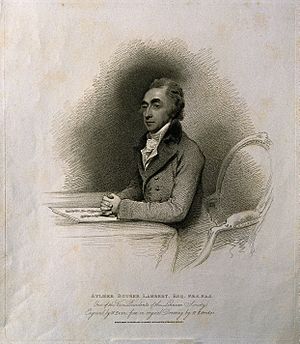Aylmer Bourke Lambert facts for kids
Quick facts for kids
Aylmer Bourke Lambert
|
|
|---|---|
| Born |
Aylmer Bourke Lambert
2 February 1761 |
| Died | 10 January 1842 (aged 80) |
Aylmer Bourke Lambert (born February 2, 1761 – died January 10, 1842) was an important British botanist. A botanist is a scientist who studies plants. He was one of the first members, called fellows, of the Linnean Society. This is a famous group for scientists who study nature. Lambert spent his life studying plants and collecting many different types of plant specimens.
Contents
Early Life and Education
Aylmer Bourke Lambert was born in Bath, England, on February 2, 1761. His father was Edmund Lambert, and his mother was Bridget Bourke. Sadly, his mother passed away in 1773. That same year, he started school.
Through his mother's family, he received land in Jamaica and Ireland. Lambert went to Newcome's School, which was for sons of important families. After that, he studied at Oxford University for three years.
Amazing Books About Pines
Lambert is most famous for his big book called A description of the genus Pinus. A genus is a group of similar living things. This book was published in parts between 1803 and 1824. It was a beautifully illustrated book that showed all the conifers known at that time. Conifers are trees like pines, firs, and spruces.
He made a second large edition of the book from 1828 to 1837. A third, smaller edition came out in 1832. Each copy of these books was often unique. This can make it tricky for scientists to use the pictures to identify plants.
Many new conifers found by explorers like David Douglas were first described in Lambert's books. This included the giant Coast Redwood tree. Other scientists, like David Don, also added their work to Lambert's books.
His Huge Plant Collection
Lambert gathered many important collections of dried plant specimens, called a Herbarium. These collections came from famous explorers and botanists like Johann Reinhold Forster and Archibald Menzies. He also collected many specimens and drawings from Australia. This was right after the First Fleet arrived there.
Many people sent him plants and drawings from Australia. These included Governor Arthur Phillip and Surgeon-General John White. Other contributors were Colonel William Paterson and Philip Gidley King.
Lambert's collection had about 50,000 preserved plant specimens. He also had a very large library. Many famous botanists used his collection for their studies. After he passed away, his collection was sold in many parts. Today, you can find pieces of his amazing collection in botanical gardens all over the world.
Working with Science Societies
Lambert was one of the first members of the Linnean Society when it started in 1788. This society is dedicated to the study of natural history. In 1796, he became one of the four vice-presidents of the Linnean Society of London. He held this important role until he died in 1842.
In 1791, Lambert was also chosen to be a member of the Royal Society. This is another very old and respected group for scientists in London. Joseph Banks, a famous botanist, made Lambert a member of its Council in 1810.
Lambert was a good friend of Sir Joseph Banks. He was very interested in the new plants and animals being discovered in Australia. These discoveries were sent back to London as live plants, dried specimens, seeds, or drawings. Lambert helped organize the collection of specimens and drawings from Surgeon General John White.
How He Is Remembered
Aylmer Bourke Lambert is honored in the names of several plants and animals. The scientific name for the Sugar Pine tree is Pinus lambertiana. A genus of Australian plants is named Lambertia. Even a bird, the variegated fairywren, has his name in its scientific name (Malurus lamberti).
When you see the short name Lamb. after a plant's scientific name, it means Aylmer Bourke Lambert was the one who first described that species.



